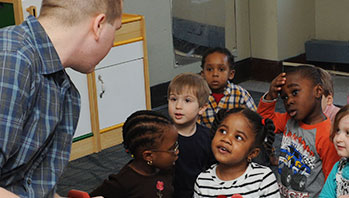- blue crayons or color paint squares (various shades of blue)
- blue
- color
- dark
- darker
- darkest
- environment
- light
- lighter
- lightest
- shade
MA Standards:
Speaking and Listening/SL.PK.MA.1: Participate in collaborative conversations with diverse partners during daily routines and play.
Language/L.PK.MA.1: Demonstrate use of oral language in informal everyday activities.
Language/L.PK.MA.6: Use words and phrases acquired through conversations, listening to books read aloud, activities, and play.
Language: L.PK.MA.5.a: Demonstrate understanding of concepts by sorting common objects into categories (e.g., sort objects by color, shape, or texture).
Head Start Outcomes:
Language Development/Receptive Language: Attends to language during conversations, songs, stories, or other learning experiences.
Language Development/Expressive Language: Uses language to express ideas and needs.
Language Development/Expressive Language: Uses increasingly complex and varied vocabulary.
PreK Learning Guidelines:
English Language Arts/Language 2: Participate actively in discussions, listen to the ideas of others, and ask and answer relevant questions.
English Language Arts/Language 3: Communicate personal experiences or interests.
Talk Together: Introduce Color

© Commonwealth of Massachusetts, Department of Early Education and Care (Jennifer Waddell photographer). All rights reserved.
STEM Key Concepts: There are many different colors; A color can have many different shades (from very light to very dark)
ELA Focus Skills: Color Recognition, Speaking and Listening, Vocabulary
Educator Prep: Place squares of different shades of blue in a line from lightest to darkest.
Tell children they will be learning about color. Hold up a color square and ask, Do you see this color anywhere in the room? Allow time for children to look around and respond.
Explain to children that noticing the colors around them is one way of learning about their environment—or the world they live in. Tell children that they will explore colors inside and outside. Say, Today we are going to explore inside.
Point to your clothing and ask children to identify a few colors they know. Then focus on the color blue. Ask questions such as,
- Who is wearing blue today (even just a little bit)?
- What do you notice about the blue color in the clothes we are wearing? Are they all the same blue color?
Draw attention to the line of blue paint squares and say, Notice the difference in all the blues. Point out and label one square that is light blue and place it next to one that is dark blue. Say, They are different shades of blue. Let’s look at different shades of blue in the clothes we are wearing. Point to children or have them stand next to each other and ask questions such as,
- Is <Armand> wearing light blue or dark blue?
- Is <Nancy’s> shirt lighter or darker than Armand’s?
- Who has the lightest color blue in their jeans?
Invite children to continue compare and describe the different shades of blue by prompting them to stand next to one another or to place the articles of clothing (hats, pretend play clothing, mittens, etc.) next to one another.
English Language Learners: Help children grasp the meaning of comparative words light, lighter, lightest and dark, darker, darkest by reinforcing with visual aids. Help children learn one group of comparative words first (light, lighter, lightest or dark, darker, darkest) before introducing them together. Use visuals as you discuss color shades, for example display three blue socks and have children identify the shade as they place them in order. As they do so, ask questions such as, Which sock is the lightest of the three socks? Have children answer in full sentences using the comparative words, This sock is the lightest.
